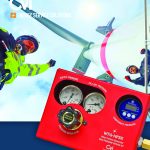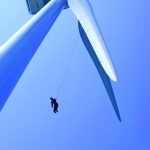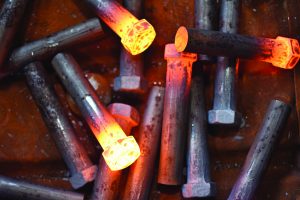Wind farms are often in remote areas that aren’t always easily accessible. And once at a site, wind technicians still have to fight the elements at heights upward of 300 feet.
Bottom line: inspecting a wind turbine is hard work. CloudVisit Energy, however, is working to make some of that labor a little easier and more efficient.
As renewable energy becomes more economical, it continues to grow by leaps and bounds. But as it grows, the machinery becomes more intricate, and the need to inspect and maintain that equipment becomes even more essential.
With CloudVisit Energy’s remote inspection software, a technician is able to have a virtual staff at his fingertips.
Daniel Gilbert, president, CEO, and founder of CloudVisit Energy, was able to parlay his experience in the telecommunication field to the inspection and maintenance of wind turbines.
“In 2016, we were contacted by a major publicly traded telecommunications company, Ericsson,” he said. “The system that we developed for them is used for the remote inspection of mobile communication systems. Ericsson is a world leader in developing and manufacturing all the radios and the infrastructure that runs mobile phone systems.”
Wind, Gilbert discovered, was no different.

Industry similarities
“There are a lot of similarities between that industry and the wind industry. You’re dealing with generally inaccessible locations, and the installation and maintenance projects are similar, too,” he said. “This type of work is very skilled and requires multiple skillsets.”
CloudVisit Energy’s software enables a division of labor. Using this software, the technician doing the installation of the equipment does the work, and the inspector with the expertise in inspecting the construction and completion of projects is at a central office connected to the technician in the tower, according to Gilbert.
“Our system enables the inspector to connect directly with the technician doing the work,” he said. “It can be very hard to find a technician who also has the equivalent skills as an inspector. That’s the similarity that we saw in the industries, and with my interests in wind and renewable energy, it was a natural progression.”
And Gilbert said his company’s software can be used in many industries, as well as the spectrum of wind-based energy: onshore and offshore.
Customizable
“Our system is a customizable cloud-based software solution that optimizes the efficiency and safety of these projects,” Gilbert said. “Our system ensures that the industry continues to expand efficiently, safely, and cost-effectively by using this tool. But we have worked on major infrastructure projects for so long, we understand how the work can be delegated and separated between remote inspectors and people on site.”
CloudVisit Energy developed a customizable workflow for wind energy based on the company’s experience with the telecommunications industry, according to Gilbert.
“The emphasis is on collaboration, and our system is really a tool, and the collaboration between the inspector at the main office and the technician is what drives efficiencies and gets the work done correctly,” he said.
Part of the collaboration is a video conferencing link between the operator and the technician that works with low bandwidths, which is crucial for remote sites, according to Gilbert.

Software backbone
“Collaboration is a huge aspect, and it’s the backbone of the software,” said Genevieve Pfeiffer, content marketing manager with CloudVisit Energy.
Industry-specific functionalities exist to ensure everyone stays focused and keeps records, according to Pfeiffer.
“We have the video conferencing aspect, but there’s a lot more,” she said. “We also have different functionalities, such as a multipurpose checklist. This allows the experts, who are remotely working, to create a checklist, which serves as a punch-list for on-site technicians. The inspection can’t be verified until everything’s done and signed off on.”
Along with the video conferencing, the software allows high-definition images to be taken as well, according to Pfeiffer.
“Inspectors can annotate those pictures,” she said. “They can draw on them to make specific points on the picture stand out and make notes on those as well. Those are just a few of those functionalities. There are a lot more, but we think that those combined with the video conferencing are what really makes the software stand out.”
Gilbert agreed.
“Having those kinds of records are essential,” he said. “If there are issues found at a later time, you have a detailed record of the project from the beginning. It’s the combination of the collaboration and the functionality and the workflow, which again reflects our deep understanding of large infrastructure projects.”
Pfeiffer added that this combination is essential with large projects made up of massive labor and heavy machinery.
Software training
CloudVisit Energy’s software is a first important step, but it doesn’t end there. Training and working with clients on the software is also key, according to Gilbert.
“Our software is a tool, and the tool is only as good as the people that use it,” he said. “So, we really focus on working directly with a client on training, on adopting and ensuring that the tool is being embraced and used correctly. Because, ultimately, the utilization and the correct use of the system is what’s going to drive efficiencies, improve outcomes, lower costs, and improve safety. We really focus on understanding the client’s requirements, their priorities, and developing a phased implementation. We offer the full spectrum of support, which includes training and ongoing updates to the workflow of the system. So, we really become part of the team.”

15-year mark
CloudVisit Energy recently marked its 15th year in the business in January, and Gilbert noted that he’s found it interesting that many industries share the same challenges.
“I see there are a lot of industries that think the problems they have are unique to them, but really there are a lot of similarities in a lot of the issues,” he said. “That really was the genesis of our software.”
And it all grew from CloudVisit Energy’s relationship with Ericsson.
“Our work in the telecom industry is really over the top,” Gilbert said. “I think it’s very significant, the work that we’ve done with Ericsson. It’s been significant working with one of the global leaders in telecommunications. They’re using our system, which is really the foundation for their global sales and services. It’s very transformative to be part of that. Our system is being used now for current installations, but it’s going to play a major role in 5G rollout.”
Gilbert said he has a close affinity with the wind industry, and he sees it as a renaissance of sorts on the horizon of the U.S.’s energy future.
“For the time being, fossil fuels and natural gas are going to play a part, but I would hope that as wind technology becomes more common, the cost will come down, and the benefits will become greater. In terms of a company, our product map is very focused on the technology adoption with the first version of our system that involves human operators,” he said. “Then the next iteration would be combining augmented reality with drones.”
Nurturing wind
Gilbert has a passion for the wind industry, and he and his company are working hard to ensure this form of renewable energy flourishes and continues to grow.
“It’s obviously beneficial to the environment; it’s good for the economy; there have been a lot of studies that show investments in renewable energy and wind have a much higher multiplier than similar investments in petroleum, oil exploration, and mining,” he said. “In terms of the macro picture, we need more of these projects, because ultimately, they drive innovation; they create jobs; they’re good for the environment, and they’re good for the country, and they’re good for our security. Overall, the result is in the creation of better-paying jobs. It’s just a win-win outcome for everyone, and that’s one reason why we’re so interested to really see these projects become more ubiquitous.”
And CloudVisit Energy’s software can help drive that future, according to Gilbert.
“We’re at the crossroads of really great opportunities, and we have developed a tool that can drive innovation and the utilization of wind energy,” he said. “It’s really just a great time.”








































